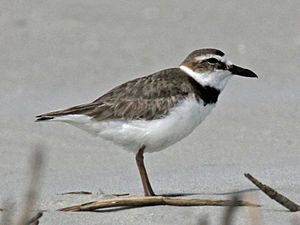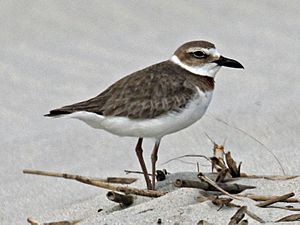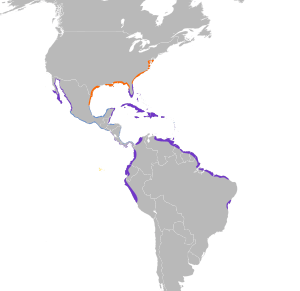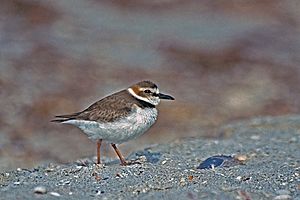Wilson's plover facts for kids
Quick facts for kids Wilson's plover |
|
|---|---|
 |
|
| Breeding male (pair of below) | |
 |
|
| Breeding female (pair of above) | |
| Conservation status | |
| Scientific classification | |
| Genus: |
Charadrius
|
| Species: |
wilsonia
|
 |
|
The Wilson's plover (Charadrius wilsonia) is a small bird that lives near the coast. It belongs to the Charadriidae family, which includes many types of plovers and lapwings. This bird is known as a wader, meaning it often walks through shallow water to find food.
Wilson's plovers breed along the coasts of North and South America. You can find them from the equator all the way north to the eastern coast of the United States. They also live along the Pacific coast of Mexico.
Contents
Where Wilson's Plovers Live and Travel
Wilson's plovers are coastal birds. They make their nests right on sandy beaches or sandbars. They create a simple hollow in the sand for their eggs.
Many of these birds are migratory. This means they travel long distances between their breeding grounds and their winter homes. Plovers from the United States (except Florida) fly south to Brazil for the winter. Some birds from Mexico travel to Peru. There are also some Wilson's plovers that live in Brazil all year round.

What Wilson's Plovers Look Like
Wilson's plovers are small birds. They have some unique features that help you tell them apart.
When a male is ready to breed, he has a black band across his chest. He also has black feathers around his eyes and on the front of his head. The area around his face is a reddish-brown color.
Females and males who are not breeding look a bit different. Their black markings are replaced with brown or reddish-brown colors. Non-breeding birds also have a slightly grayer look on their heads and chest bands.
Young plovers look similar to the females. Sometimes, their chest band is not fully formed. The top part of an adult plover's body is mostly dark gray. They have a short white stripe on their wings and white feathers on the sides of their tail. Their belly is white, except for the chest band. Their legs are pink, and they become brighter when it's breeding season.
One of the most noticeable things about the Wilson's plover is its bill. It's dark, large, and heavy for a bird of its size. When they call, it sounds like a high, soft whistle.
Wilson's Plover Measurements
Here are some typical sizes for these birds:
- Length: 6.3 to 7.9 inches (16 to 20 centimeters)
- Weight: 1.9 to 2.5 ounces (55 to 70 grams)
- Wingspan: About 19 inches (48.2 centimeters)
What Wilson's Plovers Eat
Wilson's plovers search for food on beaches. They usually find their meals by looking carefully as they walk slowly across the sand. They really enjoy eating crabs! But they also eat insects and marine worms.
History of the Name
This bird was named after a Scottish-American bird expert named Alexander Wilson. His friend, George Ord, gave the bird its name in 1814.
See also
 In Spanish: Frailecillo de Wilson para niños
In Spanish: Frailecillo de Wilson para niños


